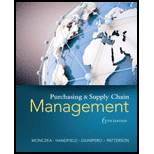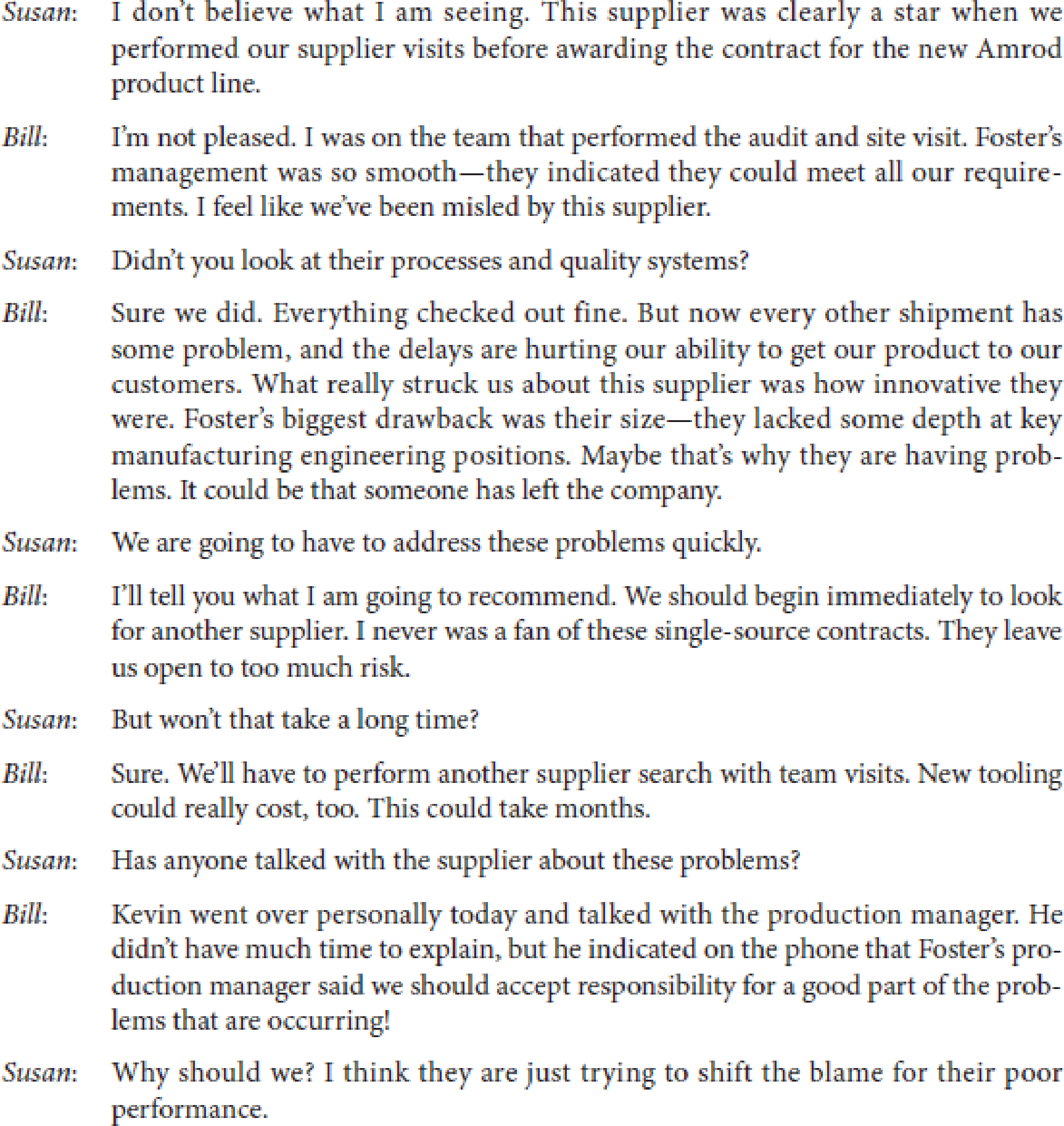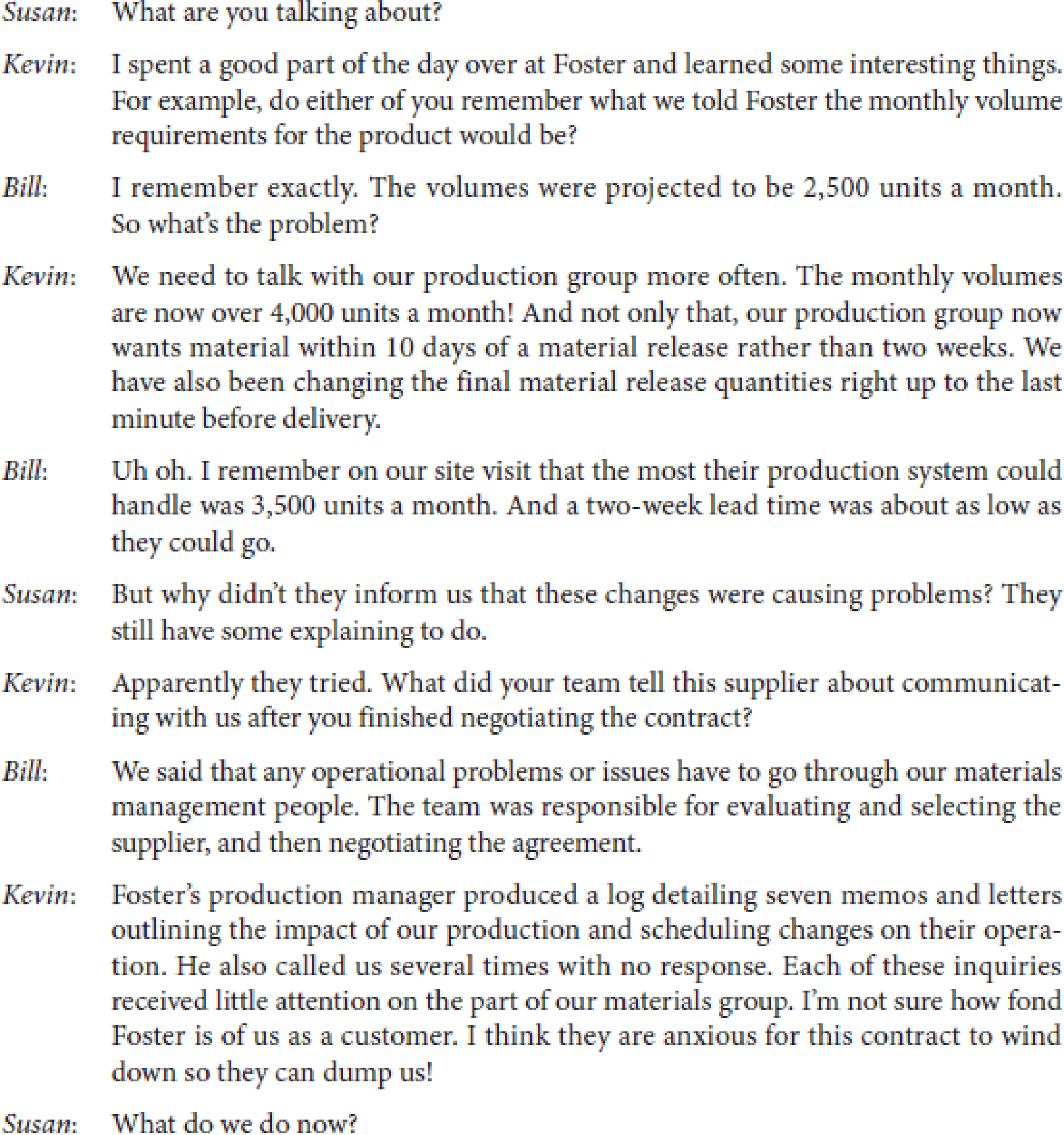
Purchasing and Supply Chain Management
6th Edition
ISBN: 9781285869681
Author: Robert M. Monczka, Robert B. Handfield, Larry C. Giunipero, James L. Patterson
Publisher: Cengage Learning
expand_more
expand_more
format_list_bulleted
Concept explainers
Textbook Question
Chapter C, Problem 1.7A
Avion, Inc.
Susan Dey and Bill Mifflin, procurement managers at Avion, Inc., sat across from each other and reviewed a troubling performance report concerning a key supplier, Foster Technologies. The report detailed the deteriorating performance of Foster Technologies in the areas of material quality and on-time delivery.

At this point, Kevin O’Donnell, another procurement manager, entered the room.


Why can changes within a supply chain disrupt the normal flow of goods and services within a supply chain?
Expert Solution & Answer
Want to see the full answer?
Check out a sample textbook solution
Students have asked these similar questions
Sales of tablet computers at Marika Gonzalez's electronics store in Washington, D.C., over the past 10 weeks are shown in the table below:
Week
1
2
3
4
5
6
7
8
9
10
Demand 21 21
27
38 25
30 35
24 25
30
a) The forecast for weeks 2 through 10 using exponential smoothing with a = 0.50 and a week 1 initial forecast of 21.0 are (round your responses to two decimal places):
Week
1
2
3
4
5
6
7
8
9
10
Demand 21
21
27
38 25
30
35
24 25 30
Forecast 21.0 21
21
24 31
28
29
32 28 26.50
b) For the forecast developed using exponential smoothing (a = 0.50 and initial forecast 21.0), the MAD = |||||sales (round your response to two decimal places).
Sales of tablet computers at Marika Gonzalez's electronics store in Washington, D.C., over the past 10 weeks are shown in the table below:
Week
Demand
1
2
3
4
5
6
7
8
9
10
21
21
27
38
25
30
35 24 25
30
a) The forecast for weeks 2 through 10 using exponential smoothing with a = 0.50 and a week 1 initial forecast of 21.0 are (round your responses to two decimal places):
Week
1
2
3
4
5
Demand 21 21
27 38
Forecast 21.0
☐ G
☐
☐
6
7
25 30 35
∞ ☐
8
9
10
24
25
30
Each machine costs $3 Million. Building the room with all its attendant safety protection and other ancillary costs increases the spending by an additional $2.0 million dollars per MRI suite. Each machine can perform 2000 scans per year.
Each reading of an MRI scan by a radiologist, along with other per-scan-related costs, is $500 per scan.
The machine will last five years.
Don’t worry about discount rates for this problem
Graph the total costs over 5 years as a function of sales for 0-3000 patients annually. Hint: you may need to add a second MRI at some point.
Suppose that you want to make a profit of $500 per scan at a target volume of 1000 patients per year, and you purchase only one machine. Superimpose the total revenue curve on top of the total cost curve in (1).
Chapter C Solutions
Purchasing and Supply Chain Management
Ch. C - Avion, Inc. Susan Dey and Bill Mifflin,...Ch. C - Prob. 1.2ACh. C - Prob. 1.3ACh. C - Prob. 1.4ACh. C - Prob. 1.5ACh. C - Avion, Inc. Susan Dey and Bill Mifflin,...Ch. C - Avion, Inc. Susan Dey and Bill Mifflin,...Ch. C - Prob. 1.8ACh. C - Prob. 1.9ACh. C - Prob. 1.10A
Ch. C - The Global Sourcing Wire Harness Decision Sheila...Ch. C - The Global Sourcing Wire Harness Decision Sheila...Ch. C - The Global Sourcing Wire Harness Decision Sheila...Ch. C - The Global Sourcing Wire Harness Decision Sheila...Ch. C - The Global Sourcing Wire Harness Decision Sheila...Ch. C - Prob. 3.1ACh. C - Prob. 3.2ACh. C - Prob. 3.3ACh. C - Prob. 3.4ACh. C - Prob. 3.5ACh. C - Prob. 3.6ACh. C - Prob. 3.7ACh. C - Prob. 3.8ACh. C - Prob. 3.9ACh. C - Prob. 3.10ACh. C - Prob. 3.11ACh. C - Prob. 3.12ACh. C - Prob. 3.13ACh. C - Prob. 5.1SACh. C - Prob. 5.2SACh. C - Prob. 5.3SACh. C - Prob. 5.4SACh. C - Prob. 5.1SBCh. C - Prob. 5.2SBCh. C - Scenario 3 Ben Gibson, the purchasing manager at...Ch. C - Scenario 3 Ben Gibson, the purchasing manager at...Ch. C - Scenario 4 Sharon Gillespie, a new buyer at...Ch. C - Scenario 4 Sharon Gillespie, a new buyer at...Ch. C - Scenario 4 Sharon Gillespie, a new buyer at...Ch. C - Prob. 6.2ACh. C - Prob. 6.3ACh. C - Prob. 6.4ACh. C - Prob. 6.5A
Knowledge Booster
Learn more about
Need a deep-dive on the concept behind this application? Look no further. Learn more about this topic, operations-management and related others by exploring similar questions and additional content below.Similar questions
- I need the answer to requirement C.arrow_forwardImagine you are Susan Kim and are faced with a difficult choice to either follow the orders she was given, or refusing to do so. Using each lens determine what the ethical response would be. Suppot your answer with materials from readings and lectures. For example, using Universalism what would the ethical response be? Do the same for all four lenses.arrow_forwardAnswer all these questions, selecting any company of your choice. Choose a specific type of food company. Select a specific product. Develop all the inputs that are part of the process. Develop the transformation process in a graphic (diagram, etc.). Develop all the outputs or finished products that are part of the process. Describe all the processes involved in one line of production in any manufacturing facility. Also describing how good management is the center of any part of a production company.arrow_forward
- Using exponential smoothing with α =0.2, forecast the demand for The initial forecast for January is 2000 tons. Calculate the capacity utilization for June, July and Discuss the implications of underutilized or over utilized capacity for Green Harvestarrow_forwardIn organizational development when results are improving but relationships are declining, what leadership style is appropriate? directing delegating supporting coachingarrow_forwardWhat is the first thing a leader should do when moving through a cultural change? conduct an assessment comparing the practices to other high-performing organizations learn about the current organizational culture continue to monitor key metrics define expectationsarrow_forward
- The third change leadership strategy, Collaborate on Implementation, is designed to address what type of concerns? impact concerns personal concerns refinement concerns collaboration concernsarrow_forwardIf team members are concerned with specifics such as their tasks, contingency plans, resources, and timeline, what concerns do they have? implementation concerns impact concerns refinement concerns personal concernsarrow_forwardAt the developing stage of organizational development, which leadership style is most appropriate? supporting coaching delegating directingarrow_forward
- During the start-up phase of organizations, which leadership style is appropriate? supporting coaching directing delegatingarrow_forwardRegarding relationships and results, what is typically seen in start-up orgnanizations? low results/high relationships low results/low relationships high results/high relationships high results/ low relationshipsarrow_forwardWhat issues lie within Employee and Labor relations with hours worked and how to solve the issues effectively.arrow_forward
arrow_back_ios
SEE MORE QUESTIONS
arrow_forward_ios
Recommended textbooks for you
 Purchasing and Supply Chain ManagementOperations ManagementISBN:9781285869681Author:Robert M. Monczka, Robert B. Handfield, Larry C. Giunipero, James L. PattersonPublisher:Cengage Learning
Purchasing and Supply Chain ManagementOperations ManagementISBN:9781285869681Author:Robert M. Monczka, Robert B. Handfield, Larry C. Giunipero, James L. PattersonPublisher:Cengage Learning Contemporary MarketingMarketingISBN:9780357033777Author:Louis E. Boone, David L. KurtzPublisher:Cengage Learning
Contemporary MarketingMarketingISBN:9780357033777Author:Louis E. Boone, David L. KurtzPublisher:Cengage Learning

Purchasing and Supply Chain Management
Operations Management
ISBN:9781285869681
Author:Robert M. Monczka, Robert B. Handfield, Larry C. Giunipero, James L. Patterson
Publisher:Cengage Learning

Contemporary Marketing
Marketing
ISBN:9780357033777
Author:Louis E. Boone, David L. Kurtz
Publisher:Cengage Learning

Inventory Management | Concepts, Examples and Solved Problems; Author: Dr. Bharatendra Rai;https://www.youtube.com/watch?v=2n9NLZTIlz8;License: Standard YouTube License, CC-BY